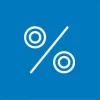In Switzerland, medium-term notes are bonds. They work much like fixed deposits: You entrust an amount of money to the issuer (normally a bank) for a fixed, predetermined period of time. You receive interest at a pre-agreed fixed rate throughout the bond term. At the end of the term, the issuer repays the entrusted money. Your money is blocked until the medium-term note reaches its maturity date, and normally cannot be cashed out without paying high penalty fees.
The minimum bond term for Swiss medium-term notes is one year, and the maximum term is ten years in most cases. The interest rate is fixed, which means the annual interest rate which you agreed to when you bought the medium-term notes applies across the entire bond term. The rate does not change regardless of fluctuations in financial markets. As a general rule, the longer the fixed bond term of a medium-term note is, the higher its fixed annual interest rate is.
Medium-term notes can be a suitable investment vehicle for people with low risk tolerance who have capital which they can do without for medium to long terms. Some companies also invest in medium-term notes because the fixed interest rates simplify financial planning. Because Swiss medium-term notes have a low risk of loss, their interest rates are also low compared to the returns which can possibly be achieved by some other investment vehicles (stocks, for example).
Because medium-term notes are securities, a custody account is required in order to hold them. Many Swiss banks do not charge custody fees for their own medium-term notes.
More on this topic:
Compare Swiss medium-term notes now
Fixed deposits vs. medium-term notes
Tips for investing in fixed deposits and medium-term notes




